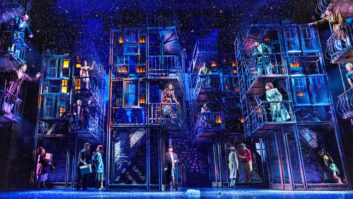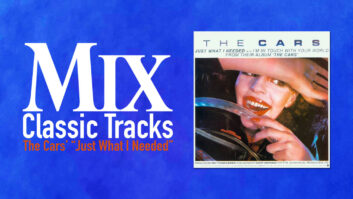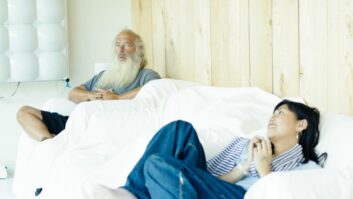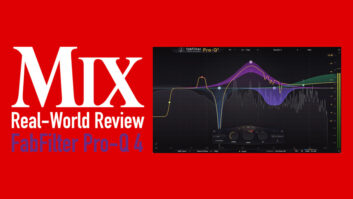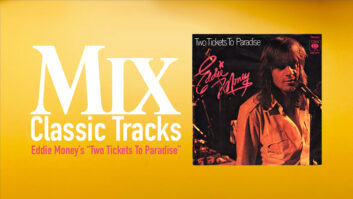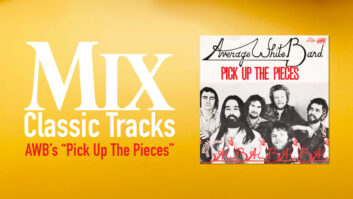
Yankee Stadium, October 18, 1977. “Reg-gie! Reg-gie! Reg-gie!” The chant builds louder and louder in the cavernous stadium as Yankee slugger Reggie Jackson, who has already hit two homers in this sixth game of the World Series against the L.A. Dodgers, steps into the batter’s box in the bottom of the eighth inning. Pitcher Charlie Hough floats one of his famous knuckleballs across the plate and — pow! — there it goes! Jackson’s improbable third homer of the game seals the series victory for the Yanks and brings a first championship trophy to the team’s colorful owner, George Steinbrenner. Uptown, downtown, through all the boroughs and beyond, it’s bedlam!
Other scenes from New York in 1977 — the year of Mix magazine’s birth 3,000 miles away from the Big Apple, in the San Francisco Bay Area — are not quite as pleasant. There was the big blackout in mid-July that led to riots, looting and thousands of arrests. There was the ongoing terror of the Son of Sam serial murders, which kept the city in the grip of fear for months on end until the culprit, David Berkowitz, was apprehended in August ’77. The city’s economy was in shambles, leading to the election that fall of a fiscally conservative new mayor, Ed Koch. And like every other city, New York suffered mightily during the great Mideast oil crisis that so bedeviled the newly elected president, Jimmy Carter, and led to maddening gas rationing for a spell.
Ah, but 1977 was a sweet time in the music and recording business in New York! Despite some supply problems concerning petroleum-based products (like vinyl) brought on by the oil crisis, the music industry as a whole was enjoying an explosive growth period, which led to a proliferation of new studios and clubs all around the New York metropolitan area.
THE PROJECTS
The sheer diversity of projects filled studios big and small, as this was the era when both disco and punk/new wave were going strong, in addition to all the mainstream pop, rock, jazz and classical that had always brought business to New York studios. “A lot of studios did either disco or new wave, but we did them both,” comments Tony Bongiovi, who opened the Power Station on West 53rd Street during 1977. Bongiovi got his start at Motown Studios in the ’60s, then went to Apostolic Studios in New York (the first 12-track room in New York City), then to Record Plant and Mediasound before building his own facility. His work co-producing a pair of Ramones albums helped him land a number of other new wave clients, “but we also did Chic and all sorts of disco records with Sister Sledge, Diana Ross and other people,” he recalls. Indeed, the new studio was financed largely with money Bongiovi made producing a disco smash: Meco’s “Star Wars.” During 1977, Bongiovi co-produced the groundbreaking Talking Heads: ’77 album, but Power Station hadn’t opened for business yet; instead, it was recorded at Sundragon Studios on West 20th Street and mixed at Mediasound, Harry Hirsch and Bob Walters’ incredible Baptist church-turned-studio on 57th Street.
Here’s just a taste of some of the other notable projects that came out of N.Y. studios that year:
Producer Jacques Morales and engineer Gerald Block made the classic sides by the Village People at Sigma Sound, Joe Tarsia’s highly successful New York City offshoot of his legendary Philadelphia facility. Nile Rogers and Bernard Edwards’ hit-filled Chic album was recorded by Bob Clearmountain, Michael Frondelli and others at Electric Lady, and mixed at the Power Station.

Producer/engineer Eddie Kramer was busy with the suddenly hot band Kiss, mixing the sequel to the mega-selling 1975 album Kiss Alive — recorded by Record Plant’s remote truck — at Electric Lady with Neil Dorfsman assisting, and recording a new album called Love Gun at Record Plant.
Another multi-Platinum live album from that year was an all-New York effort: Barry Manilow’s Live, produced by Ron Dante, was recorded at New York’s Uris Theatre by John Venable and mixed by Michael Delugg at Mediasound.
Meatloaf’s epic Bat Out of Hell album was mostly recorded at Bearsville Studios upstate, but mixed on a Neve console at Hit Factory. Todd Rundgren produced and co-engineered with a slew of others.
Television cut their classic first album, Marquee Moon, at Phil Ramone’s old A&R Recording with producer/engineer Andy Johns. Meanwhile, Ramone was working there on Billy Joel’s breakthrough album, The Stranger (which included “Just the Way You Are” and “Only the Good Die Young”), with engineer Jim Boyer. Ramone also worked on the Paul Simon track “Slip Slidin’ Away,” which hit the Top 5 near the end of 1977.
Bruce Springsteen’s Darkness on the Edge of Town would not be released until 1978, but much of it was recorded in the fall of 1977 by Jimmy Iovine and Chuck Plotkin at the Record Plant.

One of the great unsung punk albums, the Dead Boys’ Young, Loud and Snotty, produced by Genya Raven, was engineered by Dave Wittman and mixed by Harvey Goldberg at Electric Lady.
The Ramones’ Rocket to Russia — produced by Tony Bongiovi, Tommy Ramone and engineer Ed Stasium — was recorded at Mediasound and mixed at the just-opened Power Station.
Though Blondie’s self-titled debut album (recorded in 1976) was still selling very briskly in 1977, the band went back to the same recording facility — historic Plaza Sound Studios above Radio City Music Hall — with the same producer (Richard Gottehrer) and engineer (Rob Freeman) in June 1977 and cut Plastic Letters, a moderate hit here that yielded two Top 10 singles in the UK. That year, Gottehrer and Freeman also spearheaded the recording of the highly influential punk masterpiece Blank Generation by Richard Hell & The Voidoids, recorded at Plaza Sound and Electric Lady. Hell is widely credited with introducing the hardcore punk aesthetic to both England and New York.
The cast album for the Broadway smash Annie (11 Tony Award nominations) was recorded in April 1977 at Columbia’s 30th Street studio by producer Lewis Allen and engineer Bud Graham.
And speaking of show tunes, we would be remiss if we didn’t mention the theme song from Martin Scorsese’s film New York New York, which came out in 1977. The song, by Broadway writers Kander and Ebb, was sung by Liza Minelli in the film. However, the soundtrack album was not recorded in New York; it was cut in L.A. Frank Sinatra’s 1979 version of the title song — also recorded in L.A. — later turned it into a true standard and the modern song most associated with New York City.

Blondie returned to Plaza Sound Studios to record Plastic Letters.
Photo: richardmccaffrey.com
CONCERTS AND CLUBS
Live music venues of every size were in full swing all over town. The great rock showcase club of the day was the Bottom Line on West 4th Street. Steve Rubell and Ian Schrager’s ultratrendy Studio 54 disco emporium opened April 26, 1977, and became a world-famous magnet for the glitterati (although it was pre-dated by the much funkier 2001 Odyssey club in the Bay Ridge section of Brooklyn, where some of the dance scenes for Saturday Night Fever were filmed). The major punk emporiums were CBGB’s (which had opened in December ’73) and Max’s Kansas City, a hangout for artists, literary types and cool bands since 1965.
The Village Vanguard was (and still is) the preeminent jazz spot in the city, though at the time there was also a move by a number of avant-garde players into various loft spaces. Among the best known of these were Ornette Coleman’s Artist House, Sam Rivers’ Studio Rivbea and Ali’s Alley, operated by Rashied Ali, who drummed with John Coltrane in Trane’s final years.
Singer/songwriter-friendly clubs in Greenwich Village like the Bitter End (founded in 1962) and Kenny’s Castaways (1967) were around in 1977, and still hang on, although they are no longer considered particularly significant rooms. An important venue for experimental music, dance and performance art of various sorts was the Village club The Kitchen, which started in 1971 and operates to this day. In 1977, a mid-sized band like the Grateful Dead played at the Palladium Theatre (previously known as the Academy of Music), while the monster acts — such as Led Zeppelin — filled Madison Square Garden for multiple nights.
THE STUDIOS

Talking Heads tracked Talking Heads: 77 at Sundragon Studios. Pictured: frontman David Byrne.
Photo: richardmccaffrey.com
You almost can’t talk about the New York recording business in 1977 without mentioning Bongiovi’s justifiably legendary Power Station (today’s Avatar Studios), which opened that year. Bongiovi recalls what set his studio apart: “My engineering discipline was in acoustics and I had an idea to design a reverberation time-based room. At the time, most studios were very dead so you could get the separation, but I went the other way: I had a reverberation time of 0.75 seconds. I made sure no distance was greater than 30 milliseconds away, and I was able to section off large groups, so if you had an orchestra you could put the rhythm section in one room, the horns in one room and the strings in the other. I designed the isolation into the room, and no one had really done that before. Also, since the walls curved in, some people thought that was an acoustic no-no because it creates what’s called focusing, but I figured out a way using the slatted absorber techniques that had been around forever to dissipate that.
“It was truly a musician’s and a producer’s studio,” Bongiovi continues. “When I’d be at other studios, string players were always complaining about the acoustics and horn players said they had to overblow, so I did a lot of research into finding out what rooms they liked — such as the Eastman School of Music and the Boston Symphony Hall — and then tried to re-create some of the qualities of those studios. Whatever it was we did — and I had a lot of help from other people, of course — it seemed to work. There were no frills, no fancy furniture. Everything was designed for the technology, and the studio took off right away.” It also helped that Bongiovi managed to lure some of the top young engineers in the city to his new facility, including future recording giants Bob Clearmountain and Neil Dorfsman.
Frank Filipetti hadn’t gone full time into engineering yet in 1977, but spent the better part of six months as a producer-in-training at Bongiovi’s new studio. He was a singer/songwriter in those days, as well as an early home recordist. Using a heavily modified TEAC 4-track, he made sophisticated demos that were good enough for him to win a $5,000 first prize in the 1975 American Songwriter’s Festival (judged in part by Phil Ramone, who would become a lifelong friend later). Then he invested his winnings in even better equipment and made new demos that landed him a publishing deal with Capitol/Screengems and allowed him to move to New York (from Connecticut) three days before the big blackout.
“It was exciting because New York was truly a Mecca for musicians,” Filipetti recalls during a break from sessions with Ann Murray at Legacy Studios that Ramone is producing. “The Church [a converted Armenian church on 30th Street] was still running at Columbia, Atlantic [Studios] was still going strong, and, of course, there was Mediasound, Electric Lady, Hit Factory, then Power Station. The recording scene was really thriving, so the recording studios were not only recording acts, they were also doing production deals with artists. You’d come in at the end of the day and you’d record your stuff after the big acts had left, and you’d have great engineers like Michael Barbiero and Jeffrey Lesser, Tony [Bongiovi]. It was a great community. There were lots of clubs and a fair amount of money was being spent on productions. Even the disco music, which a lot of people thumbed their noses at, was bringing in live orchestras. Looking back, you would never think that New York would slide into the situation it’s in now, with so many studios closing. Back then, there were dozens and dozens of studios, dozens of clubs — rock clubs, jazz clubs, discos; just a tremendous live music scene, which is where so much of the studio work came from.”
The recording projects described in this article detail not only a who’s who of recording artists, producers and engineers of the day, but also an A-list of recording facilities: Mediasound, Sundragon, Record Plant, Electric Lady, Plaza Sound, A&R, Columbia, Sigma Sound, Hit Factory. Some of the other popular studios of the day included 24-track facilities such as Harry Hirsch’s Soundmixers (a division of Sound One, the biggest post house of that era), A-1, Celebration, Latin Recording, C.I. (which was mostly jazz), East Side Sound, Secret Sound, Sound Ideas, RCA (mainly classical and pop), RPM and Bob Liftin’s Regent Sound (lots of jazz, but also plenty of TV post work, including Saturday Night Live). Among the top 16-track rooms of the day were Sear Sound, Downtown Sound, Skyline and Dick Charles Recording.
Of course, then and now there was more to the recording industry than just music. Commercial advertising work had long been centered in Manhattan, and big and small jobs for radio and TV were spread out among numerous specialty studios, from tiny 4-track rooms to big 24-track facilities. One of the biggest in 1977 (and today) was Howard Schwartz Recording, founded in 1975 as a jingle house primarily, but grew steadily through the years to be able to incorporate major music recording and post work. (As fate would have it, Schwartz’s studio was on the cover of the first issue of Mix to feature New York studio listings, from October 1979.)
“Nineteen seventy-seven was a bad year financially in the city of New York with the oil embargo and the prime rate through the roof, and we were planning on building two more studios because our first two studios were booked solid,” recalls Schwartz, who had worked with Wally Heider in L.A. before moving to New York. “At that time, we were just working really hard. A lot of fantastic musicians in and out of the space every day — we were working with Ed Lubunski, who was a famous jingle guy, David Horowitz, who is still around. I was doing some Kiss albums at night — each guy was doing an individual album; I had Gene Simmons for four or five months.”
When it came to the dance music craze, Schwartz says, “Disco was great because it was all cash. You sold your studio at night to the disco guys. If they didn’t have the money, you didn’t turn the power on. I learned that from someone else in the business, because all the slime was in the disco business. It was kind of payola-y.
“The late ’70s was a time when if you were entrepreneurial at all, the cost of entry was only moderately high,” he continues. “A good console cost $300,000, a tape machine was between $38,000 and $55,000. But you could make a living building and operating a recording studio because it was before the Synclavier, and it was before home studios, so if people needed to make a record, they had to go to a recording studio and that was a wonderful thing.”
In this pre-digital era, there were fewer gear choices for studio owners than there are today. There were a couple of different price points for 24-track rooms. The better-funded studios often combined Neve consoles and Studer multitracks. The more popular and economical choice, though, was probably MCI consoles and recorders. Trident, Harrison and API consoles filled some control rooms, and many studios also opted to go with 3M M79 multitracks or Ampex MM1200s tape machines. Crown and McIntosh monitor amps ruled the day, and outboard gear ran the gamut from pieces now considered “classic” (Pultec EQs, UREI limiters, Fairchilds, etc.) to the still newish (and expensive) Eventide H910 Harmonizer and the EMT 250 digital reverb. At the 16-track studio level, you’d find more Auditronics, Electrodyne, MCI, Allen & Heath and Tangent boards, along with a fair number of custom models; as well as MCI, Ampex, Tascam and Scully recorders.
Though Schwartz describes the New York recording scene in 1977 as “highly competitive” and “not particularly close-knit,” he says he made many friends in the business during the years, “and as long as everyone was making money, everything was okay. I remember back then the AES show in New York was a huge week,” Schwartz recalls. “Everyone would come to New York, and we used to fight over who got the tours. Personally, I didn’t want the tire-kickers coming around looking at my studios. But I always wanted to go on a tour, especially to Sigma, to see how they EQ’d and compressed the bass drum, because it was the most amazing sound!” [Laughs]
“It was a business then, but it wasn’t just a business then,” Filipetti comments. “Now, it’s almost exclusively a business. Everything is analyzed and second-guessed and bottom-lined and cross-checked and audited and previewed and post-viewed, whereas back then you made your music and everybody did what they could and there was a real camaraderie among people. There was competition, but also camaraderie. That’s one of the things we’re losing now with the home studio environment — that thing where you walk into a studio and there are six different acts working there and you all hang out in reception together and you talk about what you’re doing and you get a vibe. It was really a happening thing. You felt it wherever you went. And for me, a kid from Connecticut, it was unbelievable.”

In the live room at Mediasound (L-R), engineer Joe Jorgensen, chief engineer Fred Christie and studio founder Harry Hirsch
Photo: Howard Sherman
